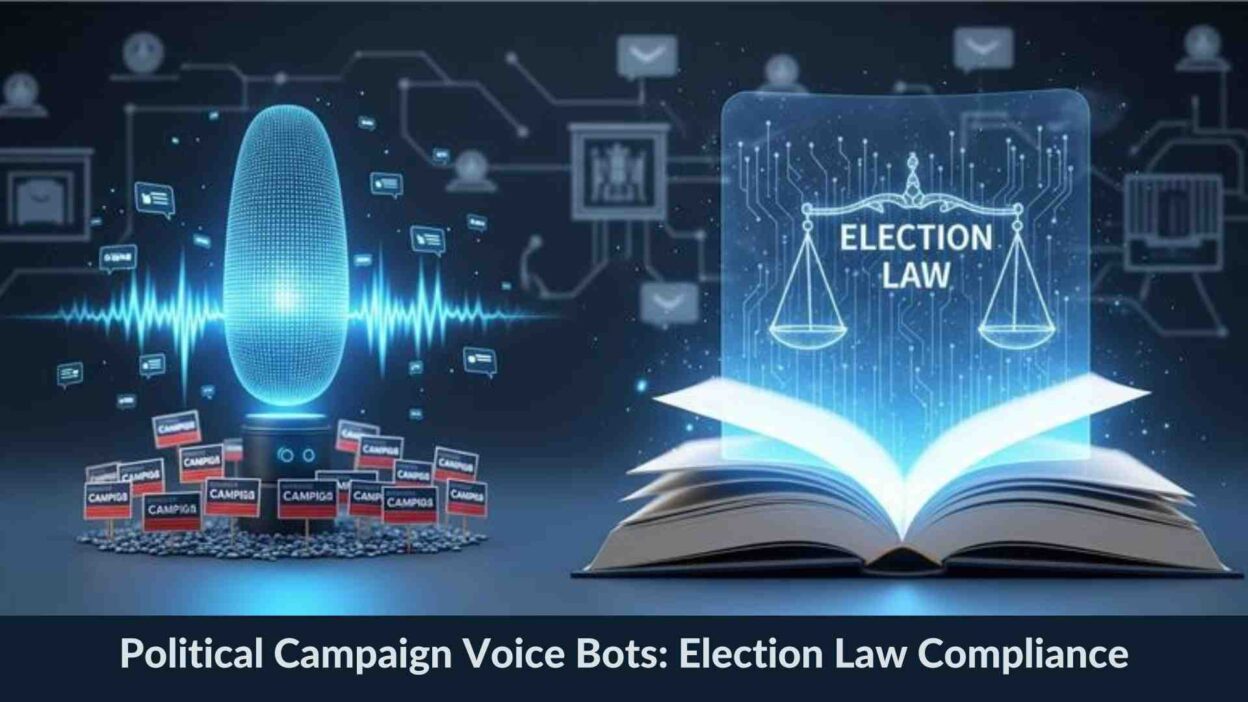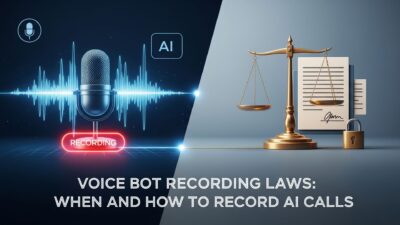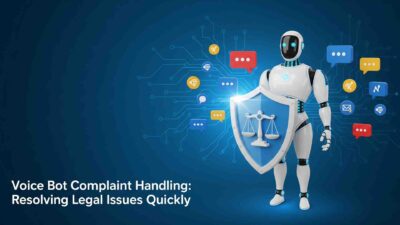TL;DR
Political campaign voice bots are transforming how candidates reach voters. These AI-powered systems automate phone calls for campaign messaging. Technology offers unprecedented scale for voter outreach. Legal compliance remains the biggest challenge for campaign teams.
Table of Contents
Understanding Political Campaign Voice Bots
Voice bots use artificial intelligence to conduct phone conversations. They deliver pre-recorded messages to targeted voter lists. Advanced systems can respond to basic voter questions. Technology replaces traditional robocall systems with interactive experiences.
Campaign teams program bots with specific talking points. Messages focus on candidate positions and voting reminders. Voice synthesis creates natural-sounding conversations. Voters often cannot distinguish between human and AI callers.
How Voice Bot Technology Works
Text-to-speech engines convert written scripts into audio. Machine learning models generate human-like voices. Natural language processing handles voter responses. Systems route complex questions to human operators.
Political campaign voice bots process thousands of calls simultaneously. Cloud infrastructure scales based on campaign needs. Real-time analytics track call success rates. Data helps optimize messaging strategies.
Benefits for Campaign Operations
Voice bots reduce campaign staffing costs significantly. Automation handles repetitive voter contact tasks. Teams focus on strategic campaign activities. Technology enables 24/7 voter outreach capabilities.
Cost savings reach up to 70% compared to human callers. Campaigns contact more voters with smaller budgets. Message consistency improves across all calls. Error rates drop compared to manual dialing.
Legal Framework for Campaign Voice Bots
Election laws govern all forms of voter communication. Voice bot campaigns must comply with federal regulations. State laws add additional compliance requirements. Violations carry severe penalties for campaigns.
Federal Election Commission Guidelines
FEC rules require clear caller identification. Political campaign voice bots must state sponsoring organization. Disclaimer requirements apply to all automated calls. Campaigns must maintain detailed call records.
Contribution limits affect voice bot funding sources. Corporate funding restrictions apply to campaign technology. Foreign nationals cannot fund voice bot systems. Disclosure requirements cover technology vendors.
Telephone Consumer Protection Act Compliance
TCPA restricts automated calling practices. Written consent is required for most voice bot calls. Time restrictions limit calling hours. Do-not-call registry compliance is mandatory.
Violations result in $500-$1,500 fines per call. Class action lawsuits target non-compliant campaigns. Legal costs often exceed campaign budgets. Proper consent documentation protects against lawsuits.
State-Specific Regulations
States impose additional voice bot restrictions. Some require human operators for transfers. Others mandate specific disclosure language. Registration requirements vary by jurisdiction.
California requires detailed caller identification. Texas restricts calling methods and timing. New York mandates consent documentation. Florida has specific disclaimer requirements.
Registration and Disclosure Requirements
Many states require voice bot registration. Campaigns must file technology usage reports. Vendor information needs disclosure. Operating procedures require documentation.
Registration fees range from $50 to $500 annually. Filing deadlines vary by state. Penalties for non-compliance include system shutdown. Legal counsel helps navigate complex requirements.
Consent and Opt-Out Mechanisms
Explicit consent protects against legal challenges. Campaigns must document permission clearly. Opt-out options must be immediately available. Removal requests require prompt processing.
Political campaign voice bots need automated opt-out systems. Voice commands should trigger immediate removal. Confirmation messages verify successful opt-outs. Suppression lists prevent future contacts.
Technical Compliance Features
Modern voice bot platforms include compliance tools. Built-in consent management systems track permissions. Automated disclosure delivery ensures legal requirements. Real-time monitoring prevents violations.
Call Recording and Documentation
Legal compliance requires comprehensive call logs. Systems must record all voter interactions. Documentation includes timestamps and responses. Storage requirements follow data retention laws.
Voice recordings serve as legal evidence. Quality assurance reviews prevent compliance issues. Audit trails track system modifications. Backup systems protect against data loss.
Automated Compliance Monitoring
AI systems monitor calls for compliance violations. Real-time alerts flag potential issues. Automatic corrections prevent legal problems. Compliance dashboards track regulatory adherence.
Political campaign voice bots integrate compliance checking. Systems validate caller ID accuracy. Disclaimer delivery gets automatic verification. Time restriction enforcement prevents violations.
Best Practices for Campaign Implementation
Successful voice bot campaigns require careful planning. Legal review should precede system deployment. Staff training ensures proper operation. Regular audits maintain compliance standards.
Pre-Launch Compliance Checklist
Verify all registration requirements are complete. Test disclaimer delivery systems thoroughly. Validate consent documentation processes. Confirm opt-out mechanisms work properly.
Legal counsel should review all scripts. Compliance officers must approve calling lists. Testing phases should include regulatory scenarios. Documentation systems need final verification.
Ongoing Monitoring and Maintenance
Daily compliance reports track system performance. Regular audits identify potential issues. Staff training updates cover regulatory changes. Vendor updates require compliance review.
Political campaign voice bots need continuous oversight. Monitoring systems should flag unusual patterns. Response protocols handle compliance emergencies. Legal teams review significant changes.
Common Compliance Pitfalls
Many campaigns underestimate regulatory complexity. Consent documentation often proves inadequate. Disclaimer delivery frequently fails requirements. Opt-out systems may not work properly.
Inadequate Consent Documentation
Verbal consent alone is insufficient protection. Written documentation provides legal defense. Consent forms must include specific language. Timestamp records prove consent timing.
Digital signatures offer strong legal protection. Email confirmations create paper trails. SMS opt-ins provide convenient documentation. Database storage enables easy retrieval.
Improper Disclaimer Delivery
Disclaimers must be clear and prominent. Voice delivery should be easily understood. Timing requirements vary by jurisdiction. Message content needs legal review.
Political campaign voice bots must deliver disclaimers consistently. Automated systems ensure proper timing. Voice quality affects legal compliance. Regular testing prevents delivery failures.
Technology Vendor Selection
Choose vendors with compliance expertise. Request detailed regulatory documentation. Verify insurance coverage for violations. Check client references carefully.
Vendor Compliance Capabilities
Leading vendors offer built-in compliance features. Systems should include consent management. Automated disclaimer delivery is essential. Real-time monitoring prevents violations.
Compliance support should include legal updates. Training programs help staff understand requirements. Technical support handles compliance emergencies. Regular updates address regulatory changes.
Contract and Liability Considerations
Vendor contracts should specify compliance responsibilities. Liability allocation protects campaign interests. Insurance requirements cover potential violations. Termination clauses address compliance failures.
Service level agreements define compliance standards. Penalty clauses discourage violations. Indemnification protects against legal costs. Regular reviews ensure continued compliance.
Cost-Benefit Analysis
Voice bot technology requires significant investment. Compliance costs add to system expenses. Legal consultation fees increase budgets. Training programs need funding.
Implementation Costs
Initial setup fees range from $10,000 to $50,000. Monthly licensing costs average $2,000 to $10,000. Compliance consulting adds $5,000 to $20,000. Training programs cost $1,000 to $5,000.
Political campaign voice bots require ongoing maintenance. Technical support costs $500 to $2,000 monthly. Legal updates may require system changes. Compliance monitoring adds operational expenses.
Return on Investment
Successful campaigns achieve 300% to 500% ROI. Voter contact costs drop 40% to 70%. Staff productivity increases significantly. Message reach expands dramatically.
Cost savings often exceed implementation expenses. Reduced staff requirements lower payroll costs. Increased voter contact improves election outcomes. Technology investments pay long-term dividends.
Future Regulatory Trends
Lawmakers are developing new voice bot regulations. AI disclosure requirements are expanding. Consent standards are becoming stricter. Penalty structures are increasing.
Emerging Compliance Requirements
Artificial intelligence labeling may become mandatory. Real-time consent verification could be required. Enhanced opt-out mechanisms are under consideration. Stricter penalty structures are being proposed.
Political campaign voice bots face evolving regulations. Compliance requirements will likely increase. Technology vendors must adapt quickly. Campaigns need flexible systems.
Preparing for Regulatory Changes
Monitor legislative developments closely. Participate in industry compliance discussions. Maintain flexible system architectures. Build relationships with regulatory experts.
Legal counsel should track regulatory proposals. Compliance systems need update capabilities. Staff training must cover new requirements. Vendor relationships require ongoing evaluation.
Read More: Quantum Voice Processing: Ultra-Fast Response Generation
Conclusion

Political campaign voice bots offer powerful voter outreach capabilities. Legal compliance remains the critical success factor. Proper planning prevents costly violations. Professional guidance ensures regulatory adherence.
Technology will continue evolving rapidly. Compliance requirements will become more complex. Campaigns must prioritize legal adherence. Success depends on balancing innovation with regulation.Investment in compliance pays long-term dividends. Proper implementation protects campaign interests. Legal expertise prevents costly mistakes. Voice bot technology transforms campaign effectiveness when used responsibly.






[…] Read More: Political Campaign Voice Bots: Election Law Compliance […]
[…] AI systems achieve 95% accuracy rates in legal contexts. Legal voice AI transcription understands courtroom acoustics and multiple speakers. The technology adapts to different accents […]
[…] privilege protections remain intact with voice scheduling. Legal process automation meets all bar association technology requirements. Data encryption protects sensitive case […]